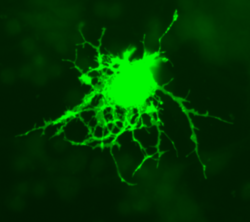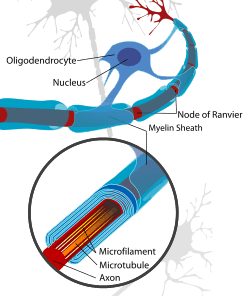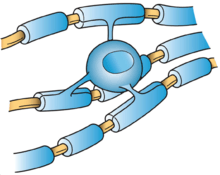Oligodendrocyte
| Oligodendrocyte | |
|---|---|
 Oligodendrocyte | |
 Oligodendrocytes form the electrical insulation around the axons of CNS nerve cells. | |
| Details | |
| Identifiers | |
| Latin | oligodendrocytus |
| Code | TH H2.00.06.2.01018 |
Oligodendrocytes (from Greek, meaning cells with a few branches), or oligodendroglia (Greek, few tree glue),[1] are a type of neuroglia. Their main functions are to provide support and insulation to axons in the central nervous system of some vertebrates, equivalent to the function performed by Schwann cells in the peripheral nervous system. Oligodendrocytes do this by creating the myelin sheath, which is 80% lipid and 20% protein.[2] A single oligodendrocyte can extend its processes to 50 axons,[3] wrapping approximately 1 μm of myelin sheath around each axon; Schwann cells, on the other hand, can wrap around only one axon. Each oligodendrocyte forms one segment of myelin for several adjacent axons.[2]
Origin
Oligodendroglia, types of glial cells, arise during development from oligodendrocyte precursor cells,[4] which can be identified by their expression of a number of antigens, including the ganglioside GD3,[5] the NG2 chondroitin sulfate proteoglycan, and the platelet-derived growth factor-alpha receptor subunit (PDGF-alphaR).[6] Most oligodendrocytes develop during embryogenesis and early postnatal life from restricted periventricular germinal regions.[7]
Oligodendrocytes are found only in the central nervous system which comprises the brain and spinal cord. These cells were originally thought to have been produced in the ventral neural tube; however, research now shows oligodendrocytes originate from the ventral ventricular zone of the embryonic spinal cord and possibly have some concentrations in the forebrain.[8] They are the last cell type to be generated in the CNS.[9]
Myelination is only prevalent in a few brain regions at birth and continues into adulthood. The entire process is not complete until about 25–30 years of age.[10]
Oligodendrocyte formation in the adult brain is associated with glial-restricted progenitor cells, known as oligodendrocyte progenitor cells (OPCs).[11] SVZ cells migrate away from germinal[11] zones to populate both developing white and gray matter, where they differentiate and mature into myelin-forming oligodendroglia.[12] However, it is not clear whether all oligodendroglial progenitors undergo this sequence of events. It has been suggested that some undergo apoptosis [13] and others fail to differentiate into mature oligodendroglia but persist as adult oligodendroglial progenitors.[14] Remarkably, oligodendrocyte population originated in the subventricular zona can be dramatically expanded by administering epidermal growth factor (EGF).[15][16]
Function

As part of the nervous system, oligodendrocytes are closely related to nerve cells, and, like all other glial cells, oligodendrocytes provide a supporting role for neurons as well as trophic support by the production of glial cell line-derived neurotrophic factor (GDNF), brain-derived neurotrophic factor (BDNF), or insulin-like growth factor-1 (IGF-1).[17] In addition, the nervous system of mammals depends crucially on myelin sheaths, which reduce ion leakage and decrease the capacitance of the cell membrane.[18] Myelin also increases impulse speed, as saltatory propagation of action potentials occurs at the nodes of Ranvier in between Schwann cells (of the PNS) and oligodendrocytes (of the CNS). Furthermore, impulse speed of myelinated axons increases linearly with the axon diameter, whereas the impulse speed of unmyelinated cells increases only with the square root of the diameter. The insulation must be proportional to the diameter of the fiber inside. The optimal ratio of axon diameter divided by the total fiber diameter (which includes the myelin) is 0.6.[10]
In contrast, satellite oligodendrocytes are functionally distinct from other oligodendrocytes. They are not attached to neurons and, therefore, do not serve an insulating role. They remain apposed to neurons and regulate the extracellular fluid.[19] Satellite oligodendrocytes are considered to be a part of the gray matter whereas myelinating oligodendrocytes are a part of the white matter.
Myelination is an important component of intelligence. Neuroscientist Vincent J. Schmithorst proposes that there is a correlation with white matter and intelligence. People with greater white matter had higher IQ's.[10] A study done with rats by Janice M. Juraska showed that rats that were raised in an enriched environment had more myelination in their corpus callosum.[20]

Pathology
Diseases that result in injury to the oligodendroglial cells include demyelinating diseases such as multiple sclerosis and various leukodystrophies. Trauma to the body, e.g. spinal cord injury, can also cause demyelination. Cerebral palsy, (sometimes developing from periventricular leukomalacia), is largely congenital and caused by damage to the newly forming brain. In cerebral palsy, spinal cord injury, stroke and possibly multiple sclerosis, oligodendrocytes are thought to be damaged by excessive release of the neurotransmitter, glutamate.[21] Damage has also been shown to be mediated by N-methyl-D-aspartate receptors.[21] Oligodendrocyte dysfunction may also be implicated in the pathophysiology of schizophrenia and bipolar disorder.[22]
Oligodendroglia are also susceptible to infection by the JC virus, which causes progressive multifocal leukoencephalopathy (PML), a condition that specifically affects white matter, typically in immunocompromised patients. Tumors of oligodendroglia are called oligodendrogliomas. The chemotherapy agent Fluorouracil (5-FU) causes damage to the oligodendrocytes in mice, leading to both acute central nervous system (CNS) damage and progressively worsening delayed degeneration of the CNS.[23] [24]
See also
Notes
- ↑ (Ragheb 1999, p. 14).
- 1 2 Carlson, Physiology of Behavior, 2010
- ↑ Baumann, Nicole; Pham-Dinh, Danielle (2001-04-01). "Biology of Oligodendrocyte and Myelin in the Mammalian Central Nervous System". Physiological Reviews. 81 (2): 871–927. ISSN 0031-9333. PMID 11274346.
- ↑ Cameron-Curry, Patrizia; Le Douarin, Nicole M. (December 1995). "Oligodendrocyte precursors originate from both the dorsal and the ventral parts of the spinal cord". Neuron. 15 (6): 1299–1310. doi:10.1016/0896-6273(95)90009-8. PMID 8845154.
- ↑ Curtis et al., 1988; LeVine and Goldman, 1988; Hardy and Reynolds, 1991
- ↑ Pringle, NP; Mudhar, HS; Collarini, EJ; Richardson, WD (Jun 1992). "PDGF receptors in the rat CNS: during late neurogenesis, PDGF alpha-receptor expression appears to be restricted to glial cells of the oligodendrocyte lineage." (PDF). Development (Cambridge, England). 115 (2): 535–51. PMID 1425339.
- ↑ Vallstedt et al., 2004
- ↑ Richardson, WD; Kessaris, N; Pringle, N (Jan 2006). "Oligodendrocyte wars.". Nature reviews. Neuroscience. 7 (1): 11–8. doi:10.1038/nrn1826. PMID 16371946.
- ↑ Thomas, JL; Spassky, N; Perez Villegas, EM; Olivier, C; Cobos, I; Goujet-Zalc, C; Martínez, S; Zalc, B (Feb 15, 2000). "Spatiotemporal development of oligodendrocytes in the embryonic brain". Journal of neuroscience research. 59 (4): 471–6. doi:10.1002/(SICI)1097-4547(20000215)59:4<471::AID-JNR1>3.0.CO;2-3. PMID 10679785.
- 1 2 3 Fields, 2008
- 1 2 Menn, B; Garcia-Verdugo, JM; Yaschine, C; Gonzalez-Perez, O; Rowitch, D; Alvarez-Buylla, A (Jul 26, 2006). "Origin of oligodendrocytes in the subventricular zone of the adult brain.". The Journal of neuroscience : the official journal of the Society for Neuroscience. 26 (30): 7907–18. doi:10.1523/JNEUROSCI.1299-06.2006. PMID 16870736.
- ↑ Hardy and Reynolds, 1991; Levison and Goldman, 1993
- ↑ Barres et al., 1992
- ↑ Wren et al., 1992
- ↑ Gonzalez-Perez, O, B; Romero-Rodriguez, R; Soriano-Navarro, M; Garcia-Verdugo, JM; Alvarez-Buylla, A (2009). "Epidermal growth factor induces the progeny of subventricular zone type B cells to migrate and differentiate into oligodendrocytes". Stem Cells. 27 (8): 2032–43. doi:10.1002/stem.119. PMC 3346259
 . PMID 19544429.
. PMID 19544429. - ↑ Gonzalez-Perez, O, B; Alvarez-Buylla, A (Jun 24, 2011). "Oligodendrogenesis in the subventricular zone and the role of epidermal growth factor". Brain Research Reviews. 67 (1–2): 147–56. doi:10.1016/j.brainresrev.2011.01.001. PMC 3109119
 . PMID 21236296.
. PMID 21236296. - ↑ Bradl (2010). "Oligodendrocytes: biology and pathology". Acta Neuropathol. 119: 37–53. doi:10.1007/s00401-009-0601-5. PMC 2799635
 . PMID 19847447.
. PMID 19847447. ...oligodendrocytes can provide trophic support for neurons by the production of glial cell line-derived neurotrophic factor (GDNF), brain-derived neurotrophic factor (BDNF), or insulin-like growth factor-1 (IGF-1).
- ↑ Sokol, 2009
- ↑ Baumann and Pham-Dinh, 2001
- ↑ Juraska J. M.; Kopcik J. R. (1988). "Sex and environmental influences on the size and ultrastructure of the rat corpus callosum". Brain Research. 450 (1–2): 1–8. doi:10.1016/0006-8993(88)91538-7. PMID 3401704.
- 1 2 Káradóttir et al., 2007
- ↑ Tkachev et al., 2003
- ↑ "Chemotherapy-induced Damage to the CNS as a Precursor Cell Disease" by Dr. Mark D. Noble, University of Rochester
- ↑ Han, R; Yang, Y. M.; Dietrich, J; Luebke, A; Mayer-Pröschel, M; Noble, M (2008). "Systemic 5-fluorouracil treatment causes a syndrome of delayed myelin destruction in the central nervous system". Journal of Biology. 7 (4): 12. doi:10.1186/jbiol69. PMC 2397490
 . PMID 18430259.
. PMID 18430259.
References
- Baumann, Nicole; Pham-Dinh, Danielle (2001). "Biology of Oligodendrocyte and Myelin in the Mammalian Central Nervous System". Physiological Reviews. 81 (2): 871–927. PMID 11274346. Retrieved 2007-07-13.
- Ragheb, Fadi (1999). "The M3 Muscarinic Acetylcholine Receptor Mediates p42mapk Activation and c-fos mRNA Expression in Oligodendrocyte Progenitors" (PDF). Ottawa: National Library of Canada. Retrieved 2006-03-07
- Raine, C.S. (1991). Oligodendrocytes and central nervous system myelin. In Textbook of Neuropathology, second edition, R.L. Davis and D.M. Robertson, eds. (Baltimore, Maryland: Williams and Wilkins), pp. 115–141.
- Tkachev D, Mimmack ML, Ryan MM, et al. (September 2003). "Oligodendrocyte dysfunction in schizophrenia and bipolar disorder". Lancet. 362 (9386): 798–805. doi:10.1016/S0140-6736(03)14289-4. PMID 13678875.
- Káradóttir, R.; D. Attwell (14 April 2007). "Neurotransmiter receptors in the life and death of oligodendrocytes". Neuroscience. 145 (4): 1426–1438. doi:10.1016/j.neuroscience.2006.08.070. PMC 2173944
 . PMID 17049173.
. PMID 17049173.
- Carlson, Neil (2010). Physiology of Behavior. Boston, MA: Allyn & Bacon. pp. 38–39. ISBN 0-205-66627-2.
- Sokol, Stacey. "The Physiology and Pathophysiology of Multiple Sclerosis". Multiple Sclerosis: Physiological Tutorial. Retrieved 2012-04-29.
- Fields, Douglas (18 February 2008). "White Matter Matters". Scientific American. 298 (March 2008): 54–61. Bibcode:2008SciAm.298c..54D. doi:10.1038/scientificamerican0308-54. Retrieved 2012-04-29.
- Menn, Benedicte; Oscar Gonzalez-Perez (26 July 2006). "Origin of Oligodendrocytes in the Subventricular Zone of the Adult Brain". The Journal of Neuroscience. 26 (30): 7907–7918. doi:10.1523/JNEUROSCI.1299-06.2006. PMID 16870736. Retrieved 2012-04-29.
- Gonzalez-Perez, O, B; Romero-Rodriguez, R; Soriano-Navarro, M; Garcia-Verdugo, JM; Alvarez-Buylla, A (2009). "Epidermal growth factor induces the progeny of subventricular zone type B cells to migrate and differentiate into oligodendrocytes.". Stem Cells. 27 (8): 2032–43. doi:10.1002/stem.119. PMC 3346259
 . PMID 19544429.
. PMID 19544429.
- Vallstedt, A; Klos JM; Ericson F (6 January 2005). "Multiple dorsoventral origins of oligodendrocyte generation in the spinal cord and hindbrain". Neuron. 1. 45 (1): 55–67. doi:10.1016/j.neuron.2004.12.026. PMID 15629702.
- Thomas, JL; Spassky N; Perez Villegas EM; Olivier C; Cobos I; Goujet-Zalc C; Martínez S; Zalc B. (15 February 2000). "Spatiotemporal development of oligodendrocytes in the embryonic brain". Journal of Neuroscience Research. 59 (4): 471–476. doi:10.1002/(SICI)1097-4547(20000215)59:4<471::AID-JNR1>3.0.CO;2-3. PMID 10679785.
- Richardson, WD; Kessaris, N; Pringle, N (2006). "Oligodendrocyte wars". Nature Neuroscience Reviews. 1. 7 (1): 11–18. doi:10.1038/nrn1826. PMID 16371946.
External links
- The Department of Neuroscience at Wikiversity
- NIF Search - Oligodendrocyte via the Neuroscience Information Framework